High speed negative-working thermal printing plates
a negative-working, thermal printing plate technology, applied in thermography, photosensitive materials, instruments, etc., can solve the problems of limiting throughput and requiring a large amount of energy
- Summary
- Abstract
- Description
- Claims
- Application Information
AI Technical Summary
Benefits of technology
Problems solved by technology
Method used
Image
Examples
example 1
[0096]This example describes the preparation of an acrylic polymer containing allyl and carboxylic acid-functionality.
[0097]A mixture of allyl methacrylate (21.4 g), methacrylic acid (3.59 g), azo-bis-iso-butyronitrile (AIBN) (0.2 g), and dodecyl mercaptan (0.06 g) in 2-butanone (909.5 g) was charged into a four-necked 2-L flask fitted with a heating mantle, temperature controller, mechanical stirrer, condenser, pressure-equalized addition funnel and nitrogen inlet. The reaction mixture was heated to 80° C. Then a mixture of allyl methacrylate (64.0 g), methacrylic acid (11.0 g), AIBN (0.4 g), and dodecyl mercaptan (0.19 g) was added over 1.5 hr. Then additional AIBN (0.1 g) was added, followed by addition of additional AIBN (0.5 g) over several hours. After 11 hr, the conversion of monomer to allyl-functional polymeric binder was greater than 98%.
[0098]The allyl-functional polymeric binder was precipitated in powder form by addition of a mixture of hexane (2.2 Kg) with stirring at ...
example 2
[0099]This example describes the preparation a homopolymer of allyl methacrylate.
[0100]A mixture of allyl methacrylate (25.0 g), AIBN (0.2 g), and dodecyl mercaptan (0.06 g) in 2-butanone (907.2 g) was charged into a four-necked 2-L flask fitted with a heating mantle, temperature controller, mechanical stirrer, condenser, pressure-equalized addition funnel and nitrogen inlet. The reaction mixture was heated to 80° C. Then a mixture of allyl methacrylate (75.0 g), AIBN (0.4 g), and dodecyl mercaptan (0.19 g) was added over 1.5 hr. Then additional AIBN (0.1 g) was added, followed by addition of additional AIBN (0.5 g) over several hours. After 10 hr, the conversion of monomer to polymer was greater than 93%.
[0101]The allyl-functional polymer was precipitated in powder form by addition of a mixture of hexane (2.2 Kg) with stirring at 4000 rpm for about 10 to 15 min, using a Series 2000, Model #84, Laboratory Dispersator. The polymer was filtered off and dried at room temperature for 24...
example 3
[0102]This example describes the preparation of an acrylic polymer containing allyl and carboxylic acid-functionality.
[0103]A mixture of allyl methacrylate (15.86 g), butyl methacrylate (5.55 g), methacrylic acid (3.59 g), AIBN (0.2 g), and dodecyl mercaptan (0.06 g) in 2-butanone (907.2 g) was charged into a four-necked 2-L flask fitted with a heating mantle, temperature controller, mechanical stirrer, condenser, pressure-equalized addition funnel and nitrogen inlet. The reaction mixture was heated to 80° C. Then a mixture of allyl methacrylate (48.0 g), butyl methacrylate (16.0 g), methacrylic acid (11.0 g), AIBN (0.4 g), and dodecyl mercaptan (0.19 g) was added over 1.5 hr. Then additional AIBN (0.1 g) was added, followed by addition of additional AIBN (0.6 g) over several hours. After 13 hr, the conversion of monomer to polymer was greater than 98%.
[0104]The allyl-functional polymer was precipitated in powder form by addition of hexane (2.0 Kg) to the reaction mixture with stirr...
PUM
| Property | Measurement | Unit |
|---|---|---|
| temperature | aaaaa | aaaaa |
| thickness | aaaaa | aaaaa |
| pKa | aaaaa | aaaaa |
Abstract
Description
Claims
Application Information
 Login to View More
Login to View More - R&D
- Intellectual Property
- Life Sciences
- Materials
- Tech Scout
- Unparalleled Data Quality
- Higher Quality Content
- 60% Fewer Hallucinations
Browse by: Latest US Patents, China's latest patents, Technical Efficacy Thesaurus, Application Domain, Technology Topic, Popular Technical Reports.
© 2025 PatSnap. All rights reserved.Legal|Privacy policy|Modern Slavery Act Transparency Statement|Sitemap|About US| Contact US: help@patsnap.com



